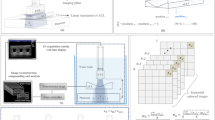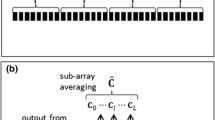Abstract
The paper addresses a crucial challenge in medical radiology and introduces a novel general approach, which utilises applied mathematics and information technology techniques, for aberration correction in ultrasound diagnostics. Ultrasound imaging of inhomogeneous media inherently suffers from variations in ultrasonic speed between tissue. The characteristics of aberrations are unique to each patient due to tissue morphology. This study proposes a new phase aberration correction method based on the Fourier transform and leveraging of the synthetic aperture mode. The proposed method enables correction after the emission and reception of ultrasonic wave, allowing for the estimation of aberration profiles for different parts of the sonogram. To demonstrate the method’s performance, this study included the conducting of experiments using a commercially available quality control phantom, an ex-vivo temporal human bone, and specially designed distortion layers. At a frequency of 2 MHz, the experiments demonstrated an increase of two-and-three-quarters in echo signal intensity and a decrease of nearly two-fold in the width of the angular distribution compared to the pre-correction state. However, it is important to note that the implementation of the method has a limitation, as it requires an aperture synthesis mode and access to raw RF data, which restricts use in common scanners. To ensure the reproducibility of the results, this paper provides public access to an in-house C + + code for aberration correction following the proposed method, as well as the dataset used in this study.








Similar content being viewed by others
Data availability
The data that support the findings of this study are openly available at https://www.researchgate.net/publication/357867058_Aberration_Correction_Raw_Ultrasound_Data_and_Computer_Program.
References
Leonov D, Kulberg N, Yakovleva T, Solovyova P (2022) Approach to detecting aberrations in transcranial ultrasound imaging. Acoust Phys 68:175–186. https://doi.org/10.1134/S106377102202004X
Deng L, Hughes A, Hynynen K (2020) A noninvasive ultrasound resonance method for detecting skull induced phase shifts may provide a signal for adaptive focusing. IEEE Trans Biomed Eng 67(9):2628–2637. https://doi.org/10.1109/TBME.2020.2967033
Aarnio J, Clement GT, Hynynen K (2005) A new ultrasound method for determining the acoustic phase shifts caused by the skull bone. Ultrasound Med Biol 31(6):771–780. https://doi.org/10.1016/j.ultrasmedbio.2005.01.019
White PJ, Clement GT, Hynynen K (2006) Local frequency dependence in transcranial ultrasound transmission. Phys Med Biol 51(9):2293–305. https://doi.org/10.1088/0031-9155/51/9/013
Ammi AY et al (2008) Characterization of ultrasound propagation through ex-vivo human temporal bone. UMB 34(10):1578–1589. https://doi.org/10.1016/j.ultrasmedbio.2008.02.012
O’Donnell M, Flax SW (1988) Phase-aberration correction using signals from point reflectors and diffuse scatterers: measurements. IEEE Trans Ultrason Ferroelectr Freq Control 35(6):768–774. https://doi.org/10.1109/58.9334
Nock L, Trahey GE, Smith SW (1989) Phase aberration correction in medical ultrasound using speckle brightness as a quality factor. J Acoust Soc Am 85(5):1819–1833. https://doi.org/10.1121/1.397889
Fink M et al (2000) Time-reversed acoustics. Rep Prog Phys 63(12):1933–1995. https://doi.org/10.1088/0034-4885/63/12/202
Kyriakou A, Neufeld E, Werner B, Paulides MM, Szekely G, Kuster N (2014) A review of numerical and experimental compensation techniques for skull-induced phase aberrations. Int J Hyperthermia 30(1):36–46. https://doi.org/10.3109/02656736.2013.861519
Clement GT, Hynynen K (2002) Correlation of ultrasound phase with physical skull properties. Ultrasound Med Biol 28(5):617–624. https://doi.org/10.1016/s0301-5629(02)00503-3
Tanter M, Aubry JF, Gerber J, Thomas JL, Fink M (2001) Optimal focusing by spatio-temporal inverse filter. I. Basic principles. J Acoust Soc Am 110(1):37–47. https://doi.org/10.1121/1.1377051
Pernot M, Montaldo G, Tanter M, Fink M (2006) ‘Ultrasonic stars’ for time-reversal focusing using induced cavitation bubbles. Appl Phys Lett 88(3):034102. https://doi.org/10.1063/1.2162700
Phillips DJ, Smith SW, von Ramm OT, Thurstone FL (1975) Sampled aperture techniques applied to B-mode echoencephalography. Acoust Hologr 6:103–120. https://doi.org/10.1007/978-1-4615-8216-8_6
Vignon F, Aubry JF, Tanter M, Margoum A, Fink M (2006) Adaptive focusing for transcranial ultrasound imaging using dual arrays. J Acoust Soc Am 120(5):2737–2745. https://doi.org/10.1121/1.2354073
Lindsey BD, Smith SW (2013) Pitch-catch phase aberration correction of multiple isoplanatic patches for 3-D transcranial ultrasound imaging. IEEE T-UFFC 60(3):463–480. https://doi.org/10.1109/TUFFC.2013.2590
Osipov LV et al (2021) Transcranial beam steering with aberration correction. Biomed Eng 54(6):438–442. https://doi.org/10.1007/s10527-021-10057-3
Kim J, Kasoji S, Durham PG, Dayton PA (2021) Acoustic holograms for directing arbitrary cavitation patterns. Appl Phys Lett 118:051902. https://doi.org/10.1063/5.0035298
Brown MD, Cox BT, Treeby BE (2020) Stackable acoustic holograms. Appl Phys Lett 116:261901. https://doi.org/10.1063/5.0009829
Aubry JF, Tanter M, Pernot M, Thomas JL, Fink M (2003) Experimental demonstration of noninvasive transskull adaptive focusing based on prior computed tomography scans. J Acoust Soc Am 113(1):84–93. https://doi.org/10.1121/1.1529663
Leung SA, Moore D, Gilbo Y, Snell J, Webb TD, Meyer CH, Miller GW, Ghanouni P, Butts Pauly K (2022) Comparison between MR and CT imaging used to correct for skull-induced phase aberrations during transcranial focused ultrasound. Sci Rep 12(1):13407. https://doi.org/10.1038/s41598-022-17319-4
Lambert W, Cobus LA, Frappart T, Fink M, Aubry A (2020) Distortion matrix approach for ultrasound imaging of random scattering media. Proc Nat Acad Sci USA 117(26):14645–14656. https://doi.org/10.1073/pnas.1921533117
Jensen JA, Nikolov SI, Gammelmark KL, Pedersen MH (2006) Synthetic aperture ultrasound imaging. Ultrasonics 44(Suppl 1):e5-15. https://doi.org/10.1016/j.ultras.2006.07.017
Passmann C, Ermert H (1996) A 100-MHz ultrasound imaging system for dermatologic and ophthalmologic diagnostics. IEEE T-UFFC 43(4):545–552. https://doi.org/10.1109/58.503714
Kulberg N, Leonov D (2021) Method for obtaining ultrasonic brain images. Patent RU 2750965
Tillett J, Astheimer J, Waag R (2010) A model of distributed phase aberration for deblurring phase estimated from scattering. IEEE T-UFFC 57:214–228. https://doi.org/10.1109/TUFFC.2010.1400
Benenson Z, Kulberg N, Elizarov A (1999) Algorithmic method for generation of a nondiffraction beam for constructing 3d high-resolution images in ultrasonic medical diagnostics. Pattern Recognit Image Analysis 9(3):492–504
Goodman JW (1968) Introduction to fourier optics. McGraw-Hill, New York
Leonov D, Kodenko M, Leichenco D, Nasibullina A, Kulberg N (2022) Design and validation of a phantom for transcranial ultrasonography. Int J Comput Assist Radiol Surg 17(9):1579–1588. https://doi.org/10.1007/s11548-022-02614-2
Fry FJ, Barger JE (1978) Acoustical properties of the human skull. J Acoust Soc Am 63(5):1576–1590. https://doi.org/10.1121/1.381852
Vignon F, Shi WT, Burcher MR, Powers JE (2008) Determination of temporal bone isoplanatic patch sizes for transcranial phase aberration correction. IEEE Ultrasonics Symp. https://doi.org/10.1109/ULTSYM.2008.0311
Aberration Correction: Raw Ultrasound Data and Computer Program. https://doi.org/10.6084/m9.figshare.18495170.v1
Acknowledgements
We would like to honor the memory of Professor Benenson ZM, as the ideas he expressed during his work at Dorodnitsyn Computing Centre were used in this study. The work was supported by the Healthcare Department (USIS No. 123031500001-4).
Funding
This paper was prepared by a group of authors as a part of the research and development effort titled “Development of design and manufacturing technology, and production of phantoms to capture more mineable data from ultrasound imaging”, (USIS No. 123031500001-4) in accordance with the Order No. 1196 dated December 21, 2022 “On approval of state assignments funded by means of allocations from the budget of the city of Moscow to the state budgetary (autonomous) institutions subordinate to the Moscow Healthсare Department, for 2023 and the planned period of 2024 and 2025” issued by the Moscow Healthcare Department.
Author information
Authors and Affiliations
Corresponding author
Ethics declarations
Conflict of interest
All authors declare no relevant conflict of interest.
Ethical approval
This article does not contain any studies with human participants or animals performed by any of the authors.
Additional information
Publisher's Note
Springer Nature remains neutral with regard to jurisdictional claims in published maps and institutional affiliations.
Rights and permissions
Springer Nature or its licensor (e.g. a society or other partner) holds exclusive rights to this article under a publishing agreement with the author(s) or other rightsholder(s); author self-archiving of the accepted manuscript version of this article is solely governed by the terms of such publishing agreement and applicable law.
About this article
Cite this article
Leonov, D., Kulberg, N., Yakovleva, T. et al. Innovative aberration correction in ultrasound diagnostics with direct phase estimation for enhanced image quality. Phys Eng Sci Med 46, 1765–1778 (2023). https://doi.org/10.1007/s13246-023-01338-0
Received:
Accepted:
Published:
Issue Date:
DOI: https://doi.org/10.1007/s13246-023-01338-0




